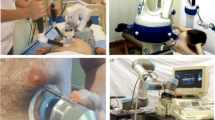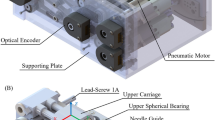Abstract
Purpose
We present a hybrid 2D–3D ultrasound (US) rigid registration method for navigated prostate biopsy that enables continuous localization of the biopsy trajectory during the exam.
Methods
Current clinical computer-assisted biopsy systems use either sensor-based or image-based approaches. We combine the advantages of both in order to obtain an accurate and real-time navigation based only on an approximate localization of the US probe. Starting with features extracted in both 2D and 3D images, our method introduces a variant of the iterative closest point (ICP) algorithm. Among other differences to ICP, a combination of both the euclidean distance of feature positions and the similarity distance of feature descriptors is used to find matches between 2D and 3D features. The evaluation of the method is twofold. First, an analysis of variance on input parameters is conducted to estimate the sensitivity of our method to their initialization. Second, for a selected set of their values, the target registration error (TRE) was calculated on 29,760 (resp. 4000) registrations in two different experiments. It was obtained using manually identified anatomical fiducials.
Results
For 160 US volumes, from 20 patients, recorded during routine biopsy procedures performed in two hospitals by six operators, the mean TRE was \(3.91\pm 3.22\) mm (resp. \(4.37\pm 2.62\) mm).
Conclusion
This work allows envisioning further developments for prostate navigation and their clinical transfer.









Similar content being viewed by others
Notes
Cumbersome equipment such as an articulated arm to hold the probe or constraining equipment such as a magnetic localizer that can be perturbed by metallic objects.
For the multi-scale method, the number of features is not preset but depends on image quality or echogenicity and is related to the selected size of the Gaussian.
References
Iremashvili V, Pelaez L, Jorda M, Manoharan M, Arianayagam M, Rosenberg D, Soloway M (2012) Prostate sampling by 12-core biopsy: comparison of the biopsy results with tumor location in prostatectomy specimens. Urology 79(1):37–42
Xu S, Kruecker J, Turkbey B, Glossop N, Singh A, Choyke P, Pinto P, Wood B (2008) Real-time MRI-TRUS fusion for guidance of targeted prostate biopsies. Aided Surg 13(5):255–264
Bax J, Cool D, Gardi L, Knight K, Smith D, Montreuil J, Sherebrin S, Romagnoli C, Fenster A (2008) Mechanically assisted 3D ultrasound guided prostate biopsy system. Med Phys 35(12):5397–5410
Baumann M, Mozer P, Daanen V, Troccaz J (2011) Prostate biopsy tracking with deformation estimation. Med Image Anal 16:562–576
De Silva T, Fenster A, Cool D, Gardi L, Romagnoli C, Samarabandu J, Ward A (2013) 2D–3D rigid registration to compensate for prostate motion during 3D TRUS-guided biopsy. Med Phys 40(2):022904
De Silva T, Cool DW, Yuan J, Romagnoli C, Samarabandu J, Fenster A, Ward AD (2017) Aaron robust 2D–3D registration optimization for motion compensation during 3D TRUS-guided biopsy using learned prostate motion data. IEEE Trans Med Imaging 36(10):2010–2020
Gillies DJ, Gardi L, Zhao R, Fenster A (2017) Optimization of real-time rigid registration motion compensation for prostate biopsies using 2D/3D ultrasound. In: SPIE medical imaging, pp 101351F–101351F
Khallaghi S, Sanchez C, Nouranian S, Sojoudi S, Chang S, Abdi H, Machan L, Harris A, Black P, Gleave M, Goldenberg L, Fels S, Abolmaesumi P (2015) A 2D–3D registration framework for freehand TRUS-guided prostate biopsy. MICCAI 9350:272–279
Selmi S-Y, Promayon E, Troccaz J (2016) 3D–2D ultrasound feature-based registration for navigated prostate biopsy: a feasibility study. In: 38th annual international conference on IEEE engineering in medicine and biology society, p 41094112
Lowe D (2004) Distinctive image features from scale-invariant keypoints. Int J Comput Vis 60(2):91–100
Arun KS, Huang TS, Blostein SD (1987) Least-squares fitting of two 3-D point sets. IEEE Trans Pattern Anal Mach Intell PAMI 9(5):698–700
Harris C, Stephens M (1988) A combined corner and edge detector, pp 147–151
Cornud F, Brolis L, Delongchamps NB, Portalez D, Malavaud B, Renard-Penna R, Mozer P (2013) TRUS-MRI image registration: a paradigm shift in the diagnosis of significant prostate cancer. Abdom Imaging 38(6):1447–1463
Fouard C, Deram A, Keraval Y, Promayon E (2012) CamiTK: a modular framework integrating visualization, image processing and biomechanical modeling. In: Payan Y (ed) Soft tissue biomechanical modeling for computer assisted surgery. Springer, Berlin, pp 323–354
Author information
Authors and Affiliations
Corresponding author
Ethics declarations
Ethical statement
All procedures performed in studies involving human participants were in accordance with the ethical standards of the institutional and/or national research committee and with the 1964 Helsinki Declaration and its later amendments or comparable ethical standards.
Conflict of interest
The authors declare that they have no conflict of interest.
Additional information
We thank Dr. P. Mozer (APHP) and Dr. G. Fiard (CHUGA) for patient data. This work was supported by the French Industry Minister through the FUI program, MIRAS project, and the Investissements d’Avenir programme (Labex CAMI) under reference ANR-11-LABX-0004.
Rights and permissions
About this article
Cite this article
Selmi, SY., Promayon, E. & Troccaz, J. Hybrid 2D–3D ultrasound registration for navigated prostate biopsy. Int J CARS 13, 987–995 (2018). https://doi.org/10.1007/s11548-018-1736-4
Received:
Accepted:
Published:
Issue Date:
DOI: https://doi.org/10.1007/s11548-018-1736-4




